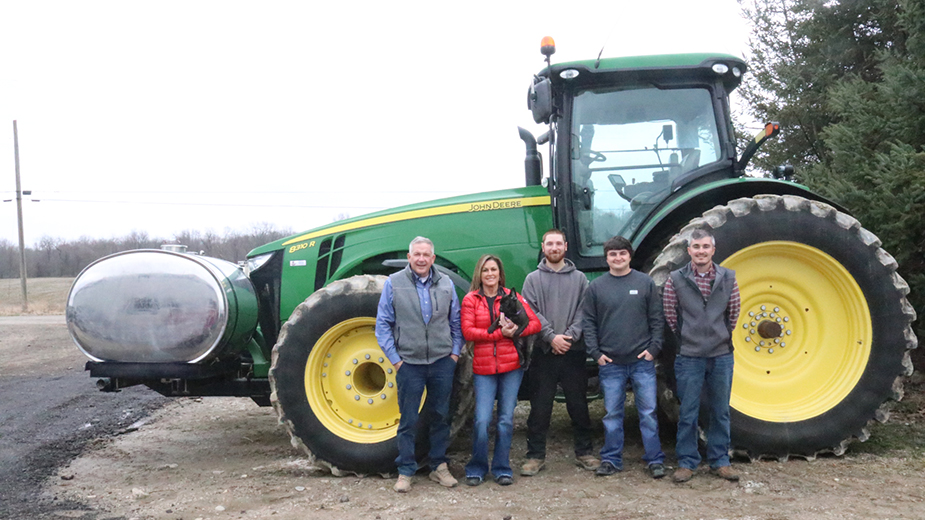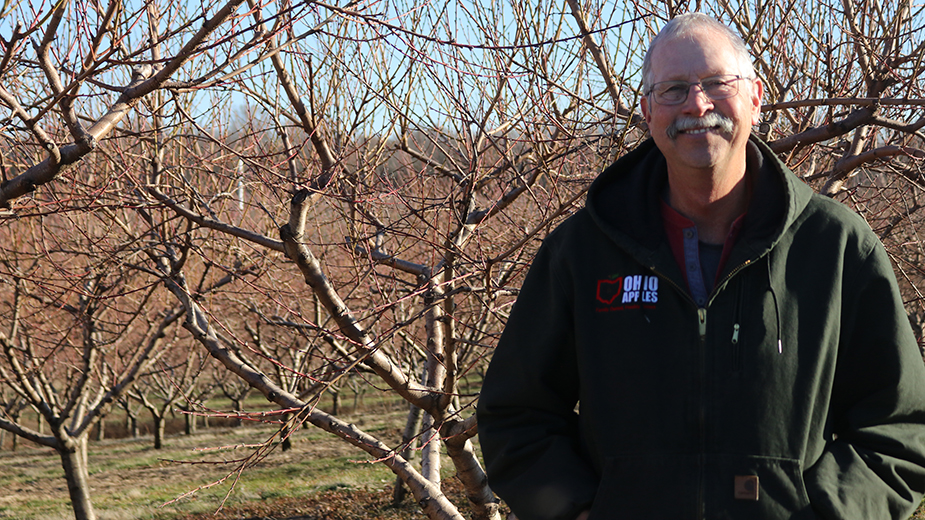YOUNGSTOWN, Ohio – Dan Simmons has worked at the family orchard since he was 11 years old. Now at 67, he looks forward to retiring, traveling and spending time with his grandchildren.
That means selling most of his Peace Valley Orchard.
Nestled in the hills and spread among the villages of Rogers, New Waterford and East Palestine, it has been in the family for 75 years. Simmons and his brothers and sisters have dedicated their lives to it.
Simmons is keeping about 50 acres, most of them behind his home, where he has a view of a valley lined with peach trees. His brother, Paul, is keeping another 100 acres. His sister and brother-in-law will continue to operate the bakery business.
But 125 acres that are 80% in orchard trees – where the family produced apples including five with patents – will be sold at auction in late March, along with the warehouse, packing facilities and a lot of the equipment.
Simmons looks forward to seeing what the fall season looks like, he says, on the outside of the packing line plant and spending more time with family. There are many chores that go with running an apple orchard that require long hours.
“I’m not disappointed with my lifestyle at all. In fact, I wouldn’t have traded it if I could,” Simmons says, but he encourages the next generation of his family to do something else.
Keeping the farm in the family was not an option, he says. How could he possibly urge his children to take a pay cut and return to the long hours it takes to operate the orchard?
“There’s not another generation coming in behind us. So what’s the endgame here?” Simmons asks. “I don’t want to be the old guy who’s just hovering around and hobbling around trying to get things done.”
Simmons believes selling the acreage will fetch enough money to keep them going through retirement. He doesn’t know if someone will buy it to plant crops or build houses, but he believes he’s unlikely to find someone interested in the business of operating an orchard.
The family decided to sell in September, long before the train derailment three miles from the orchard.
“We were uphill, upwind and upstream from everything that happened,” Simmons says, adding he could see the thick, dirty plume in the distance, but no odors from the derailment reached his property.
Russell Kiko, an auctioneer and real estate agent with Kiko Auctions, does not believe the derailment will hurt the auction of Peace Valley. “I think there will be a large crowd there,” Kiko says. “A lot of people have been there and have good memories of that place.”
Large acreage real estate in Columbiana and Mahoning counties has sharply increased in value in the past couple of years, Kiko says.
Another farm property south of Lisbon just brought between $5,700 and $6,000 per acre. But Kiko says between $6,000 and $10,000 is not uncommon in the two counties. He has seen some go as high as $18,000 per acre, depending on the location and the possibilities for development.
While some properties are being developed for commercial or housing subdivisions, Kiko says some people have been buying because they received COVID funds from the government and want to invest in something other than the markets.
In addition, Kiko says, advances in farming have allowed some farmers to take on additional property, and some will travel long distances for the opportunity to add to their land holdings.
Some investments in rural property also can be linked to people wanting to move from crowded suburban areas or seeking a getaway or hunting property.
Sales of agricultural and rural properties have been strong, and interest rates were as low as 3.5% to 4%. Kiko sees the market slowing because rates have increased to 7.5%.
With a $1 million payday for a 100-acre farm, the temptation to sell the property is hard to pass up.
Areas around North Bailey Road in Canfield, for instance, have been drawing considerable attention for commercial growth with Sheetz Inc. recently buying property zoned for agriculture there for $2.4 million.
Another 125-acre agricultural property on Maplevale Drive in Canfield Township recently sold to Pidgeon Farms LLC for $1.5 million.
An access road to that property connects it to the Maplevale development, which consists of large houses that sell for well over $500,000. But there is no plan by the buyers to convert this tract into anything but farmland.

Taylor Pidgeon, who heads the grain side of the family’s farming operation, says this property will be added to what Pidgeon Farms is already farming. From Austintown to Salem, and Homeworth to Atwater, the family grows corn, soybeans and maybe 100 acres of hay or so for the cows.
It’s easier to do a private sale instead of an auction because of the 10% fee in addition to the fee paid to the auctioneer. Pidgeon says the family keeps an eye on potential property to add, but high prices make it harder.
The price of farmland acres has gone past what a younger farmer can afford.
Brandon Kern, senior director of state and national policy for the Ohio Farm Bureau, says the average age of a farmer in Ohio is mid- to late 50s. While many young people are moving off the farm, he says there are also young people interested in starting to farm or expanding from a smaller operation to a larger one. The high price of acreage can make that difficult.
Many choose to lease land; about 50% of Ohio’s farmland is leased to larger farm operations.
The beginning farmer tax credit program, which is new this year, gives a tax break to a young farmer taking an approved agricultural finance management class and to retiring farmers who choose to sell or lease their properties to qualified beginner farmers.
In addition, Kern says there is a program through Nationwide Insurance that helps retiring farmers transition their property to the next generation.
Another program is the Farm Land Preservation Program, which has preserved nearly 100,000 acres of farmland in 60 counties.
Dan Crouse, an agent with Platz Realty Group, also has been seeing a strong real estate market for larger purchases in Trumbull and Mahoning counties. But he also sees a fair amount of commercial or industrial zoned properties, which continue to be farmed.
Development can heavily depend on whether the property has nearby sewer or water. In addition, Crouse says, in some cases farmland does not necessarily make for good residential property.
Despite a need for more housing spurred by industrial development in Lordstown, the owners of many larger properties in that village continue to use it for farmland.
Crouse points out that half of the property in Lordstown is taxed under the Current Agricultural Use Value. To qualify for CAUV, the owner must have 10 acres devoted exclusively to commercial agricultural use or generate an average agricultural income of at least $2,500 if less than 10 acres.
CAUV properties substantially lower the tax bills of working farmers. For example, in 2021 in the Lordstown School District, total CAUV valuation was $6.2 million, with $2.2 million in CAUV tax values. Market value of that property is nearly $17 million.
CAUV is one of the many programs used by farmers and those seeking to keep Ohio rural and agricultural.
Despite farm programs and efforts to save farmland, Kern says the American Farmland Trust sees 500,000 acres of agricultural land being taken out of production in Ohio by 2040. Ohio farms are top-10 producers of corn and soybeans, but farmers also supply dairy products, fruit and vegetables. Innovation and technology still allow fewer farmers to provide more production, and production numbers have not dropped.
While some farmers lease a portion of their properties for gas and oil, Kern says that removes little property from production. But large solar clusters do. Smaller farm operations may also feel more pressure toward development than larger operations.
Kern encourages farmers, developers and local officials to work together to create comprehensive plans, looking at what makes sense for development and where agricultural districts or security zones to protect farmland and agricultural heritage make sense.
Using smart growth policies, communities can prioritize growth in areas where infrastructure already supports growth.
There have been concerns about farms being purchased by foreign interests, but according to Kern, in Ohio it is just about 2%, and mostly Canadian and European buyers.
Pictured at top: Dan Simmons stands among some peach trees in his Peace Valley Orchard.
